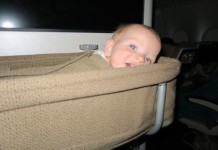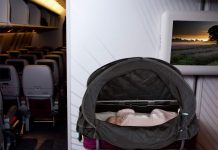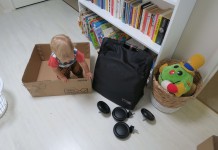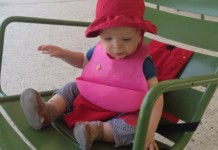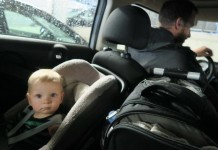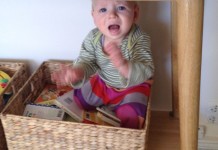Holiday or no holiday, we all want a happily sleeping baby. In fact, it’d be a rare family where, in their baby’s first year, life doesn’t revolve largely around the new baby’s sleeping habits.
In the spirit of full disclosure we’ll start with the bad news. Sometimes a baby that’s known for being an ‘easy’ sleeping baby at home might change its habits when travelling.
Don’t panic: “differently” doesn’t always equate to “disastrously”, or even “worse”. Plus, it all depends on the individual child; it’s certainly not true of all babies. The only way to find out? Experiment. Below are some possibilities of what to expect – with examples of what our founder, Sue, has experienced firsthand. Note: This post is not about choosing a travel cot (we’ve covered that here).
Four ways your baby’s sleep habits may change when travelling:
1. If they are sleeping in the same room as you (when they don’t at home).
Sue’s baby sleeps really well in almost any travel cot. But after about 8 months old, if he was in the same room as her, he woke far more often (at home or away – it’s just that when you’re away you’re more likely to be bundled in the same room). She fast learned to try to find accommodation with a separate sleeping area for her baby.
2. Sometimes, the excitement of travel will mean your baby sleeps more.
(Usually during the day –sorry.) When taken to Europe, her son upped his day sleeps by about 50%. There were more of them, and instead of two hours, they were three hours, if taken in a cot. Conversely, his afternoon nap (usually 45 minutes and happily taken in a pram) often turned into thirty minutes of ‘quiet time’ with the muslin covering the pram while he quietly gurgled to himself. After half an hour, he was done, and ‘thought’ he’d slept.
3. The excitement of a new location may mean they don’t settle on the first night.
We talk about this in our ‘how long is too long?’ post. Sue’s baby is always excited by a new location. Settling him takes longer on night one, then things move back to a new (travelling) normal after that.
4. Your baby may not like his travel cot.
An obvious problem if you’re aiming for a happily sleeping baby. The best way to safeguard against it is try him in it for a few day sleeps in the couple of weeks before you go away. At least he’ll then have a chance to get used to before the big trip, and you’ll have a chance to switch cots if you decide it’s a real problem. (For Sue’s son, all travel cots are created equal. It’s her who has strong preferences – see our post on travel cots here.)
Of course, you don’t need to metaphorically lie down and give up in any of these variations. Get proactive.
Four ways to encourage a sleeping baby while travelling.
1. Try to make their sleeping experience as similar as possible to at home.
Do they use a blanky? Take it (and a spare in case something happens in transit and you lose one.) Do they always sleep swaddled or in a sleeping bag? Take these – including spares.
2. Keep any pre-sleep rituals as similar as possible to home.
Does he have a bath, book, bed routine? Stick to this as closely as possible (even if the bath has to be a shower with you). For some babies, regular bedtime routines don’t really ‘stick’ till they are around 9 months old, for others, a regular routine will be useful earlier. You know your baby. If you’re only taking a few books, take much-loved favourites, rather than experimenting with something new: you’re aiming for comfort, not additional stimulation (there’s plenty of that available while they are travelling).
3. Figure out if your child is a ‘flexible’ sleeper or not.
If they function really well as long as they get one of their two regular day sleeps in a cot, organise your day around that. Be ready to leave the house asap after they wake, but accept that you’ll have a slow start to each day, while your baby enjoys that all important first day sleep. (Often the case for six to twelve month olds, who are on two day sleeps, all going well.)
If your child is not ‘flexible’ around his sleep, try to mess with it as infrequently as possible; time your days around ensuring your baby gets the sleep he needs in the location that he needs it (ie: a cot and a darkened room, versus a pram or a carrier – like an Ergo – while out and about). A hassle, yes, but one with a worthwhile pay off (a happy, well rested baby!) If this this your situation, choosing the right accommodation will be especially important in making this a better experience for all ages – see our tips on this here.
4. Pick and choose when you mess with ‘bedtime’.
If your child is usually in bed at 6.30pm, and you start bumping it out to 7 or 7.30pm while you’re away, it may be no problem. (Remember though, for most bubs that doesn’t mean they’ll sleep in for an extra hour in the morning.) But what it does mean is that you’re getting them used to a new routine that will be difficult to break on your return home. A late night on occasion won’t ingrain a new habit, but every night for a week or two – well, buyer beware!


